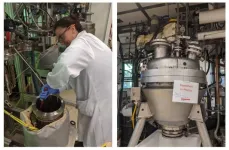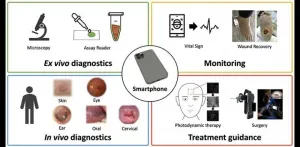(Press-News.org) URBANA, Ill. - Australian pineapple, Danish trout, and Midwestern U.S. corn farmers are not often lumped together under the same agricultural umbrella. But they and many others who raise crops and animals face a common problem: excess nitrogen in drainage water. Whether it flows out to the Great Barrier Reef or the Gulf of Mexico, the nutrient contributes to harmful algal blooms that starve fish and other organisms of oxygen.
But there's a simple solution that significantly reduces the amount of nitrogen in drainage water, regardless of the production system or location: denitrifying bioreactors.
"Nitrogen pollution from farms is relevant around the world, from corn and bean farms here in Illinois to sugarcane and pineapple farms in Australia to diverse farms bordered by ditches in Belgium. We're all dealing with this issue. It's really exciting that bioreactors are bringing us together around a potential solution," says Laura Christianson, assistant professor in the Department of Crop Sciences at the University of Illinois and lead author on a new synthesis article accepted for publication in Transactions of the American Society of Agricultural and Biological Engineers (ASABE).
Denitrifying bioreactors come in many shapes and sizes, but in their simplest form, they're trenches filled with wood chips. Water from fields or aquaculture facilities flows through the trench, where bacteria living in wood chip crevices turn nitrate into a harmless gas that escapes into the air.
This edge-of-field conservation practice has been studied for at least a dozen years, but most of what scientists know about nitrogen removal rates is based on laboratory replicas and smaller-scale experimental setups. The USDA's National Resource Conservation Service published a set of standardized bioreactor guidelines in 2015, based in part on Christianson's early field-scale work, and now more and more U.S. farmers are adding bioreactors. They're catching on in other countries, too.
The ASABE article is the first to synthesize the available data from full-size bioreactors on working farms across the world.
"After gathering all the data, the message is bioreactors work. We've shown a 20-40% reduction in nitrate from bioreactors in the Midwest, and now we can say bioreactors around the world are pretty consistent with that," Christianson says.
She adds bioreactors, like all conservation practices, have their limitations, but nitrous oxide emissions aren't one of them.
"People are worried we're just transferring nitrate in water for nitrous oxide, which is a greenhouse gas. We don't know the full story on nitrous oxide with bioreactors yet, but we can say with good confidence they're not creating a huge nitrous oxide problem," she says. "They're just not."
Christianson says farmers frequently ask her about monitoring the water in bioreactors, so she and her co-authors detail the process in the ASABE article. She also partnered with the Illinois Farm Bureau to create a series of step-by-step videos explaining how to test the water.
"For monitoring, there are two parts. You have to know how much water is flowing through the bioreactor and how much nitrogen is in the water," she says.
The short videos, which are aimed at non-researchers such as farmers and water quality volunteers, break the process down into five steps. Christianson notes her students, postdoctoral researchers, and lab staff all pulled together to create the series.
The videos are available at https://go.aces.illinois.edu/MonitoringMagic.
Christianson, who may just be the world's biggest cheerleader for bioreactors, admits the monitoring guidelines and video series are a little self-serving.
"We included recommended monitoring approaches so that more people will build them, and then more people will monitor them. And then we'll have more data to show how well bioreactors work and how we can make them work better."
INFORMATION:
The article, "Effectiveness of denitrifying bioreactors on water pollutant reduction from agricultural areas," is published in Transactions of the ASABE [DOI: 10.13031/trans.14011]. Among the 19 authors, Laura Christianson and Richard Cooke of the Department of Agricultural and Biological Engineering hail from the College of Agricultural, Consumer and Environmental Sciences at the University of Illinois.
LA JOLLA, CA--Some survivors of ebolavirus outbreaks make antibodies that can broadly neutralize these viruses--and now, scientists at Scripps Research have illuminated how these antibodies can disable the viruses so effectively. The insights may be helpful for developing effective therapies.
Ebolavirus is a family of often-deadly viruses that includes Ebola virus and many lesser-known viruses such as Bundibugyo virus, Sudan virus and Reston virus.
Structural biologists at Scripps Research used electron microscopy techniques to visualize a set of antibodies that target a key site on these viruses called the "glycan cap." Their research showed ...
MINNEAPOLIS/ST.PAUL (04/15/2021) -- New research from the University of Minnesota Medical School found mutations in a novel gene that may help identify patients with a specific form of muscular dystrophy.
The laboratory of Peter B. Kang, MD, the new director of the Paul & Sheila Wellstone Muscular Dystrophy Center at the U of M Medical School, studies the genetics and disease mechanisms of muscular dystrophy. It uses cutting-edge genomic methods to discover disease-causing mutations in patients who cannot find answers via clinical genetic test facilities.
The Kang laboratory ...
Reliance on petroleum fuels and raging wildfires: Two separate, large-scale challenges that could be addressed by one scientific breakthrough.
Teams from Lawrence Berkeley National Laboratory (Berkeley Lab) and Sandia National Laboratories have collaborated to develop a streamlined and efficient process for converting woody plant matter like forest overgrowth and agricultural waste - material that is currently burned either intentionally or unintentionally - into liquid biofuel. Their research was published recently in the journal ACS Sustainable Chemistry & Engineering.
"According to a recent report, by 2050 there will ...
DURHAM, N.C. - Researchers at Duke University have developed a method that uses machine learning, satellite imagery and weather data to autonomously find hotspots of heavy air pollution, city block by city block.
The technique could be a boon for finding and mitigating sources of hazardous aerosols, studying the effects of air pollution on human health, and making better informed, socially just public policy decisions.
"Before now, researchers trying to measure the distribution of air pollutants throughout a city would either try to use the limited number of existing monitors or drive sensors around a city in vehicles," said Mike ...
A team of scientists used a telescope on the International Space Station to measure the size of PSR J0740+6620 (J0740, for short), the most massive known neutron star. NASA's Neutron star Interior Composition Explorer (NICER) has captured unprecedented detail from this stellar remnant to learn more about matter in its core, which is on the threshold of collapsing into a black hole.
The NICER team will introduce their groundbreaking findings at a press conference during the 2021 APS April Meeting. NASA astronaut Christina Koch will join them to talk about how researchers use the space station as a science platform.
From pencils to pulsars
"Matter makes up everything we can see in the universe, from pencils ...
Researchers from Skoltech and a major European bank have developed a neural network that outperforms existing state-of-the art solutions in using transactional banking data for customer credit scoring. The research was published in the proceedings of the 2020 IEEE International Conference on Data Mining (ICDM).
Machine learning algorithms are already extensively used in risk management, helping banks assess clients and their finances. "A modern human, in particular a bank client, continually leaves traces in the digital world. For instance, the client may add information about transferring money to another person in a payment system. Therefore, every person obtains a large number of connections that can be represented as a directed graph. Such a graph gives an additional ...
A new study by Texas A&M University researchers published in END ...
Smartphones get smarter every day. These "Swiss Army knives" of mobile computing become even more useful with specialized attachments and applications to improve healthcare. Based on inherent capabilities like built-in cameras, touchscreens, and 3D sensing, as well wearable peripheral devices, custom interfaces for smartphones can yield portable, user-friendly biomedical imaging systems to guide and facilitate diagnosis and treatment in point-of-care settings.
What are the most effective ways to leverage and augment smartphone capabilities? Helpful guidelines are provided in a critical review of emerging smartphone-based imaging systems END ...
An imaging agent allows scientists to better visualize Enterobacterales infections in patients, helping to address pathogens that can be life-threatening and frequently resist antibiotics. The agent was safe in 26 patients and differentiated infections from either sterile inflammation or COVID-19-linked pneumonia in hamsters. Enterobacterales is the largest group of disease-causing bacteria in humans, and includes common pathogens such as Escherichia coli, Salmonella, and Klebsiella pneumoniae. These species have become increasingly resistant to common antibiotics, which has led the Centers for Disease Control to label some drug-resistant strains as urgent threats to human health. However, scientists still lack tools that can rapidly ...
New research from the Florida State University College of Medicine has found that the personality trait neuroticism is consistently associated with a higher risk of developing the brain disorder Parkinson's disease.
The research by Professor of Geriatrics Antonio Terracciano and team, published in Movement Disorders, found that adults in the study who scored in the top quartile of neuroticism had more than 80% greater risk of Parkinson's, compared to those who scored lower on neuroticism.
"Some clinicians think that the anxiety and depression is just the result of Parkinson's," Terracciano said. "However, our findings suggest that some emotional vulnerability is present early in life, ...



